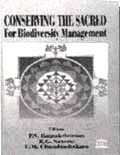For tradition`s sake
 NO ONE understands the value and significance of natural resources better than traditional societies. A realisation of the importance of these resources coupled with animistic beliefs may be the reasons why many traditional societies have been preserving a portion of natural ecosystems as "sacred groves" for centuries.
NO ONE understands the value and significance of natural resources better than traditional societies. A realisation of the importance of these resources coupled with animistic beliefs may be the reasons why many traditional societies have been preserving a portion of natural ecosystems as "sacred groves" for centuries.
Sacred groves are small patches of native vegetation traditionally protected and managed by local communities. The concept spans sacred groves to complete landscapes. Following the serious depletion and utter mismanagement of living resources by societies, there is now an interest in reviving such self-organised and regulatory conservation systems. In the age of the Convention on Biological Diversity and failure of the governments of biodiversityrich states to protect their resources, the book examines how this community management conservation system can be applied to deal with contemporary conservation issues. The publication is an Outcome Of UNESCO's Commitment in promoting scientific understanding of natural social processes relating humans to their environment under its Man and Bio-sphere (MAB) programme. Based on a year-long commissioned study involving scientists from all over the country, it gives valuable insights as to how, in spite of all the pressures, these groves continue to be maintained, though to a lesser degree.
The book goes beyond looking at sacred groves from purely a religious or cultural perspective. It examines the social, ecological, and spatial context - extending from a single species at one end to a complete landscape at the other. The book is divided into three sections. The first is devoted to conceptual and philosophical issues. An attempt is made to understand what constitutes "sacred" as against the rest of nature, and the ecological implications of the concept. It also gives an interesting account of sacred groves around the world, citing examples from countries in Asia, Africa and even Europe.
The second section is based on case studies from India, Africa, Afghanistan, Iran, Bangladesh, Pakistan, Sri Lanka, Maldives, Mongolia and the Mediterranean countries. It discusses in detail the unique "sacred forests" of Hariyali Devi in the Garbwal Himalaya. This grove is also the largest in the world. The sacred groves at Kumta, Karnataka, though in a state of decline, still provide the stakeholder with non-timber forest produce. In the Western Ghats, most of the groves have great watershed value.
This section also explores the reasons behind the decline of this "sacred" concept. It examines the role of religion, government, non-governmental organisations and local communities. Ironically, in India, most of the groves fall under the jurisdiction of government departments, many of whom are not even aware of the concept of sacred groves.
The third section deals with policy issues. A K Gupta, one of the authors, suggests that sacred groves be augmented by moulding markets, involving stake- holders and institutionalising systems for enforcing sanctions. Revival of these practices is possible only if local communities realise the tangible losses that they will incur if the groves are destroyed.
The concluding chapter, titled "Conserving the sacred: where do we stand?", stresses the importance of considering humankind as an essential component of ecosystems rather than as someone operating from outside. It calls for a need to document and monitor existing groves.
The book is peppered with interesting facts too. For instance, a number of species considered sacred are key-stone species of ecological significance. Sacred land-scapes in Sikkim, believed to be sacred by Buddhist monks, have been identified as major watershed areas. Cherrapunji's sacred groves can be best described as islands of greenery in a bleak landscape. Perhaps scientists can learn how these can best be used to rehabilitate degraded landscape.
